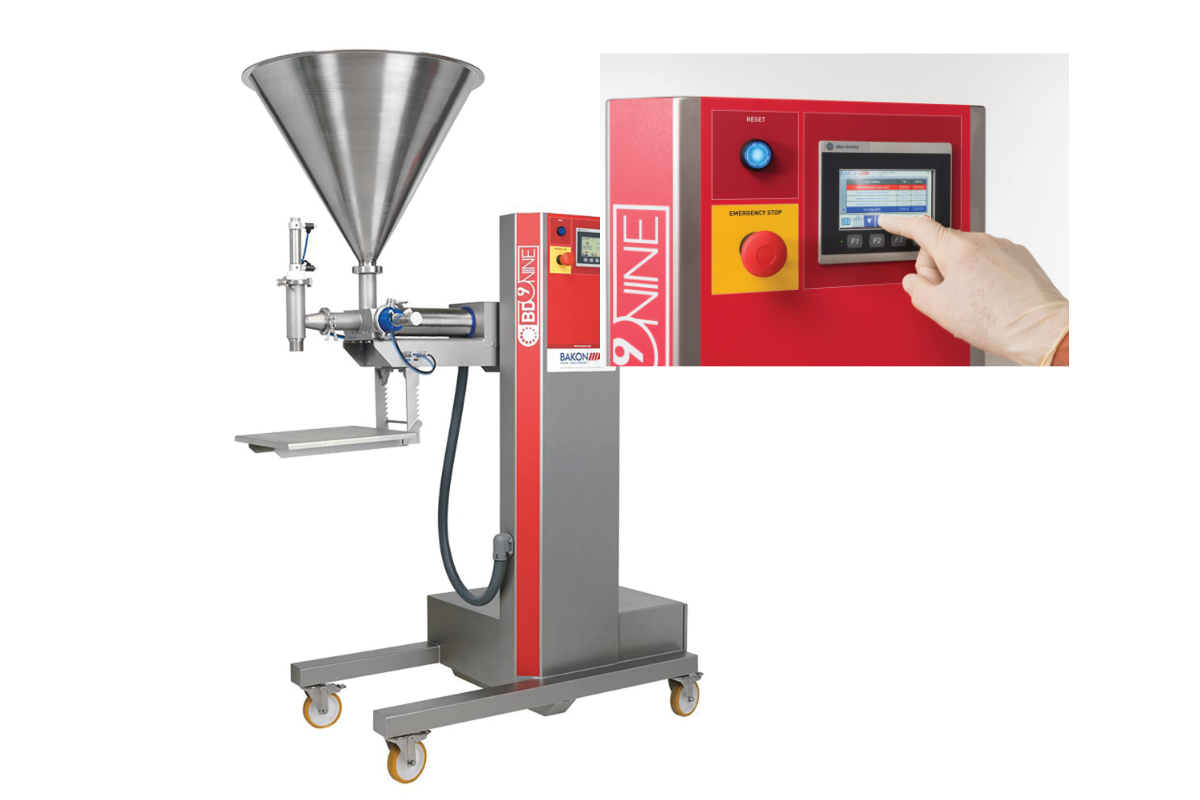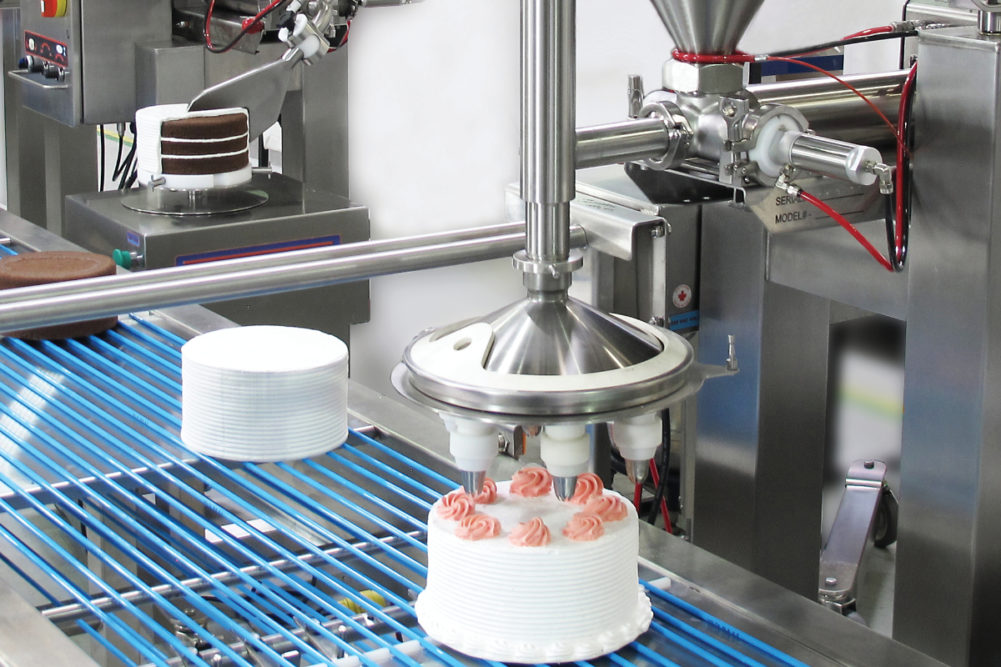KANSAS CITY, MO. - The importance of flexibility in commissary and central kitchen cake production lines has accelerated over the last few years, noted Luc Imberechts, owner of Torrance, Calif.-based Bakon Food Equipment.
Imberechts reported that his grocery customers are seeing consumers gravitate toward more than just traditional, full-sized cakes, making a versatile line of equipment key in the most modern commissaries and central kitchens.
“One of the trends we see is the need to be able to portion and think about the ways people consume the product,” Imberechts said. “The overall trend of the younger generation at least is being more conscious about the waste of food. If you know a full cake is too much, then the simple way out is to buy a smaller portion.”
A survey conducted by the International Food Information Council Foundation found that over one third of consumers of all ages always have food waste on the mind while grocery shopping, while nearly half of consumers under the age of 45 think about food waste when selecting products at the supermarket.
The need for smaller portions has also increased as the percentage of single-person households in the US has grown. According to the US Census Bureau 28.4% of US households in 2019 were made up of one person. That’s almost double the portion of single-person households in 1969, which accounted for 16.7% of the US population.
The US Census Bureau also reported that two-person households accounted for 34.5% of US households in 2019, making nearly two-thirds of households in the US two people or less. For smaller households it often doesn’t make sense to buy a full-sized cake. But grocers can still meet the needs of those consumers by offering small cakes or individual slices.
The rising trend of smaller portion sizes doesn’t, however, completely take full-sized cakes out of the minds of consumers. Nearly a third of US households are made up of three of more individuals, a setting where full-sized cakes still make sense.
“You need quite a lot of flexibility in the production line and that’s why we believe in offering lines that are very modular so that you're not always producing the same 9-inch round cake,” Imberechts said. “The idea is to be able to produce a round cake but also, with a minimum change, you are able to produce large baking sheets that you could then cut into smaller, individual portions, or possibly a square or rectangular type of cake. By doing that your offerings are much larger.”
Imberechts suggests that commissaries and central kitchens build production lines with a few points of transfer—meaning shorter conveyer belts instead of one long conveyer belt.

“Usually you give a cake line different stations. For instance, at the first station, you deposit filling and then you have more stations with specific building actions,” he said. “Say after station number two, you want to add something new. With shorter conveyer belts you can squeeze in another machine and then you build more flexibility.”
Bakon’s modular cake line can consist of the following machines:
- BD-9: piston depositor
- Gearwheel depositor
- Multi-lane piston depositor
- Enrober (waterfall) or drizzler
- Dry particulates applicator
- Robotic arm
- Syrup/glaze sprayer
- Ultrasonic cutter
Leave room for flavor — and design differentiations, too
Terry Neithercut, business development manager for British Columbia-based Unifiller Systems Inc., said she works with grocers to ensure they have the ability to differentiate their products and continually switch up the kinds of cakes they have to offer customers often dependent on flavors and colors that go with key holidays and events throughout the year.
“Unifiller solutions are versatile – making it easy for the commissary to produce exciting new offerings,” Neithercut said. “The equipment is also modular – this allows the commissary to step up production. Efficient commissary production allows the chain to offer different products (maybe a different icing) as a special or for holiday sales. When production happens at the store level – it can be difficult to get all of the locations making and offering the same product.”
She highlighted Unifiller’s Cake-O-Matic 1000i which is designed to make icing and decorating cakes easy. The machine can change icing texture from batch to batch and can function as a standalone machine or as part of a production line. The machine’s features include:
- Servo controlled turntable station
- Optional cake/cardboard centering table
- Manual cake touch-up mode at the push of a button
- Fill/ice middle layers; Top and side icing
- 4 product cylinder sizes available
- 14 US Gallon conical hopper
Neithercut highlighted that Unifiller works with grocers to match individual production level needs from single machines to fully automated lines that can guide cake production from start to finish. Unifiller’s equipment can be used with a variety of different attachments to make unique products, and machines can be added to or removed from a production line at any time.
“Often commissaries struggle with just trying to keep up,” she said. “When they become more efficient and can build inventory – they can get creative and produce new offerings for their customers.”
Unifiller’s new depositor ideal for large volume
Unifiller launched its iFill Depositor in May, a machine aimed toward bakery and food producers looking to deposit large volumes — up to 31 ounces — in a single deposit, using a simple and compact depositor.
Designed specifically for the needs of central kitchens, retail and instore bakeries, the iFill depositor is already used by one of the largest grocery chains in the United States. Featuring an ergonomic 1-inch handheld nozzle with a 5-foot food grade flexible product hose and a choice of two product cylinders, the iFill depositor pumps and portions product directly from any bowl or container.
“There are growing factors impacting the way food producers work,” said Sonia Bal, director of marketing at Unifiller. “Over the years, changes in minimum wage, fewer people entering the trades and boomers transitioning to retirement, have all led to the need for more automation. More recently, COVID-19 has demonstrated that businesses are heavily impacted when staff are difficult to retain due to health and safety concerns. The current pandemic has been eye-opening. Automating what was previously done by hand – for example, using the iFill for batter depositing – can simplify a business’ daily operations.”
The iFill includes optional attachments such as a pail shelf to keep product containers off the floor to avoid contaminants and an optional pie wand for easy pie filling, even on the rack. Although Unifiller expects this new equipment to be used mostly for cake batters and pie fillings, the application possibilities are endless.
Capable of up to 100 cycles a minute, the iFill depositor is ideal for flowable products without particulates. Customers who have purchased the equipment have been able to speed up production, increase yield, optimize their labor and better manage their product waste.
Bakon’s newest machine enhances worker safety
Earlier this year, Bakon introduced a robotic arm to its lineup of bakery production machinery. Designed to work with Bakon’s Gearwheel Depositor, the computerized arm carries out repetitive tasks such as exchanging baking trays.
The robotic arm works by taking trays from the rack and placing them in the correct place underneath the heads of the depositor with controlled 2- or 3- dimensional movement so products can be deposited into virtually any shape. The arm then takes the product-filled baking tray and places it back on the rack.
- The advantages of the robotic arm include:
- Higher productivity
- Constant product quality
- Cost reduction
- Hygienic and safe
- Can be used with various machines and applications (e.g. Piston Depositor and Disc Sprayer)
Imberechts said the idea for the robotic arm came out of requests from Bakon’s existing customer base looking for a solution to cut down on repetitive and intensive labor from moving heavy baking trays from place to place.
“It may be okay to lift a baking sheet full of product one time, but when you have to do it hundreds of times in one day, then you have an issue,” he said.
The robotic arm takes away the risk of injury from employees constantly lifting heavy trays and baking pans and frees up hands to work on other tasks.
COVID-19 makes production machines more relevant
In the times brought on by the coronavirus (COVID-19) pandemic, Neithercut pointed toward the added benefits of commissaries and central kitchens.
“Grocery retailers are looking for a method of keeping their cases full,” she said. “It has been increasingly more difficult to find decorators in-store so setting up central commissary production provides many benefits including efficiency, product consistency and the ability to produce more in less time.”
Bal predicts that grocers will need to come up with a plan to reduce the number of people in the kitchen at one time in case of future resurgences of COVID-19 later this year and next year.
The more versatile a commissary or central kitchen’s cake production line is, the more options grocers can still offer their customers without completely relying on human effort. Bal pointed out that cake production lines that use a conveyer belt to move cakes from one station to another not only provide consistent flow but also give the ability to space out operators allowing for social distancing and enhanced employee safety. Bal also highlighted the fact that all of Unifiller’s equipment is designed to be simple to clean.
“Automating certain portions of central production, so that kitchens are relying less on labor and more on equipment, such as automated icing or quick batter depositing solutions, will be instrumental in business continuity,” Bal said.
One possibility that Bakon offers is a compact cake line that can produce up to a four-layer cake in less than 33 feet. Imberechts said that this solution came out of a need for Bakon’s customers to save space, which he noted is particularly helpful in the times of COVID-19.
“We’re being asked for creative ways to reduce space: being more conscious about space and creating ways to reduce overall space and making machines more compact and reduce the number of people you need,” he said. “With COVID-19 that will be a new kind of criteria to see how many people you need on a line and how close people really need to be to one another. I think there will be changes to that in the future.”
This story is from the June 2020 issue of Supermarket Perimeter. To view the full magazine, click here.

